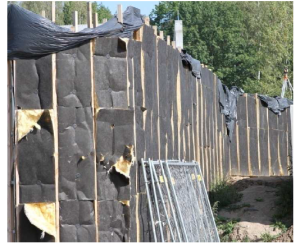 When we spak about passive housing, there is more needed than a small U-value. There is also the question of the air tightness. A nice information source is the PAROC-site, from which I made a pdf printout. They give the following U-values for passive housing:
When we spak about passive housing, there is more needed than a small U-value. There is also the question of the air tightness. A nice information source is the PAROC-site, from which I made a pdf printout. They give the following U-values for passive housing:
- Exterior wall 0.07–0.1 W/m2K
- Base floor 0.08–0.1 W/m2K
- Roof 0.06–0.09 W/m2K
- Window 0.7–0.9 W/m2K
- Solid window 0.6–0.8 W/m2K
- Entrance door 0.4-0.7 W/m2K
But for the air tightness, we need:
- Passive building n50 = 0.6
- Tight building n50 = 1
- New buildings (Finland) n50 = 3 – 4
- Normal tightness n50 = 5…10 (typical old Finnish house)
- Leaking construction n50 = 15
where n50 gives the number of times the air me be replaced per hour with a pressure difference of 50mbar. For passive housing, even the air permeability of the wall becomes important. In the following, we discuss further the case of mineral wool in passive housing.
 Due to the premeability of mineral wool, it is necessary to install an air barrier / vapour screen at the warm side and a wind screen at the cold (outside) side to avoid (cold) air intrusion.
Due to the premeability of mineral wool, it is necessary to install an air barrier / vapour screen at the warm side and a wind screen at the cold (outside) side to avoid (cold) air intrusion.
The installation of the air barrier / wind barrier is shown hereunder. It is very important that the windbarrier is at least five times more permeable for vapour than the air barrier to avoid internal condensation.
 The situation should become less critical when using high density mineral wool. The PhD work of Piotr Kosinski calculates the heat loss due to wind, even at 0.5m/s (forced convection) on the wall insulated with mineral wool. It is mentioned that on the long term a higher density has only a minimal effect. The following picture shows a more realistic wall with mineral wool and a wind barrier.
The situation should become less critical when using high density mineral wool. The PhD work of Piotr Kosinski calculates the heat loss due to wind, even at 0.5m/s (forced convection) on the wall insulated with mineral wool. It is mentioned that on the long term a higher density has only a minimal effect. The following picture shows a more realistic wall with mineral wool and a wind barrier.

Non-combustible passive housing insulation needs higher density mineral wool with all kind of barriers and a lot of risks
- inverting vapour screen and wind barrier will induce huge internal condensation in the mineral wool.
- the wind barrier can be damaged during building
These problems can be avoided by choosing for GLAPOR cellular glass because it is vapour and wind tight. GLAPOR cellular glass has about the same density as high density mineral wool (130 kg/m³) and it is produced with distinct lower temperatures. For that reason, it is sold at the same price level as high density mineral wool.
